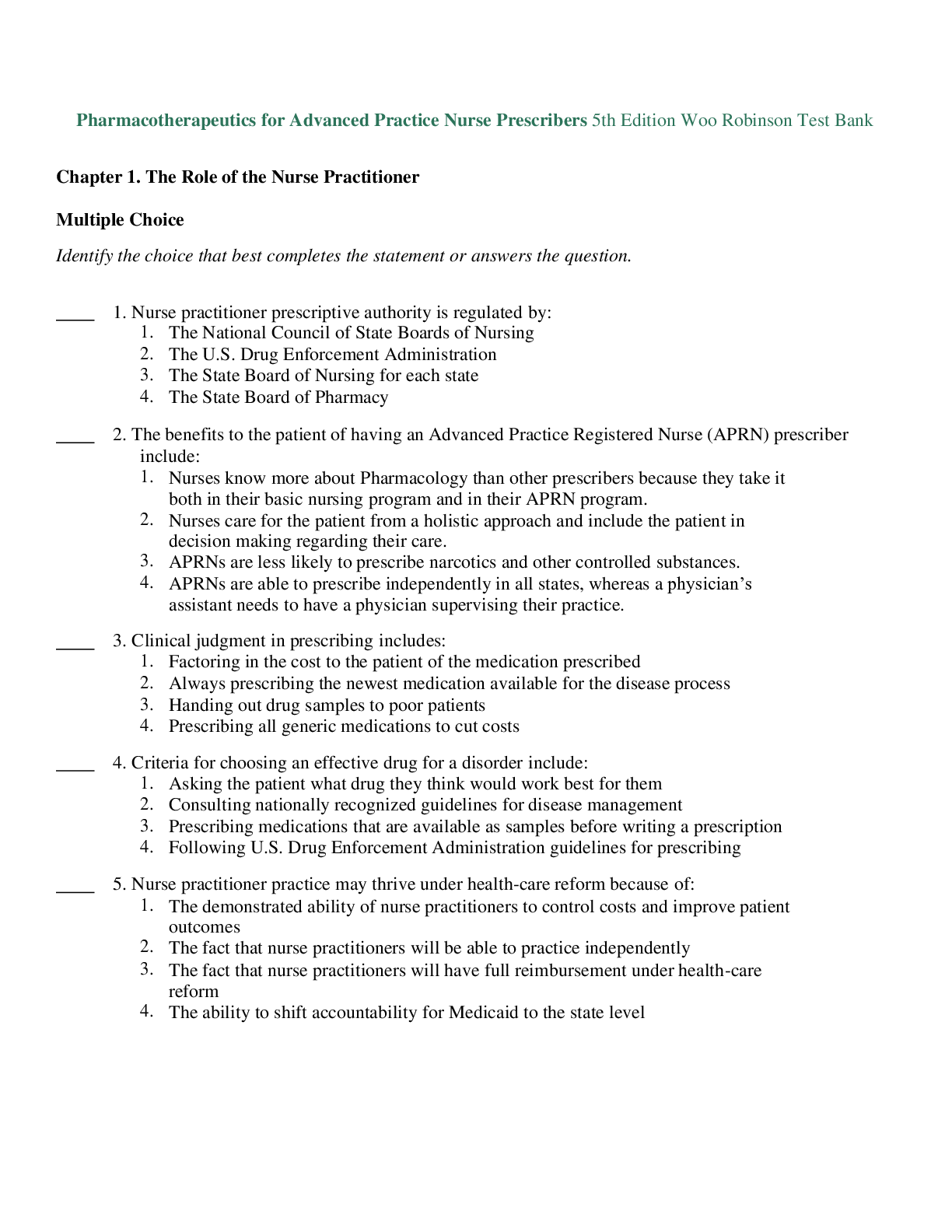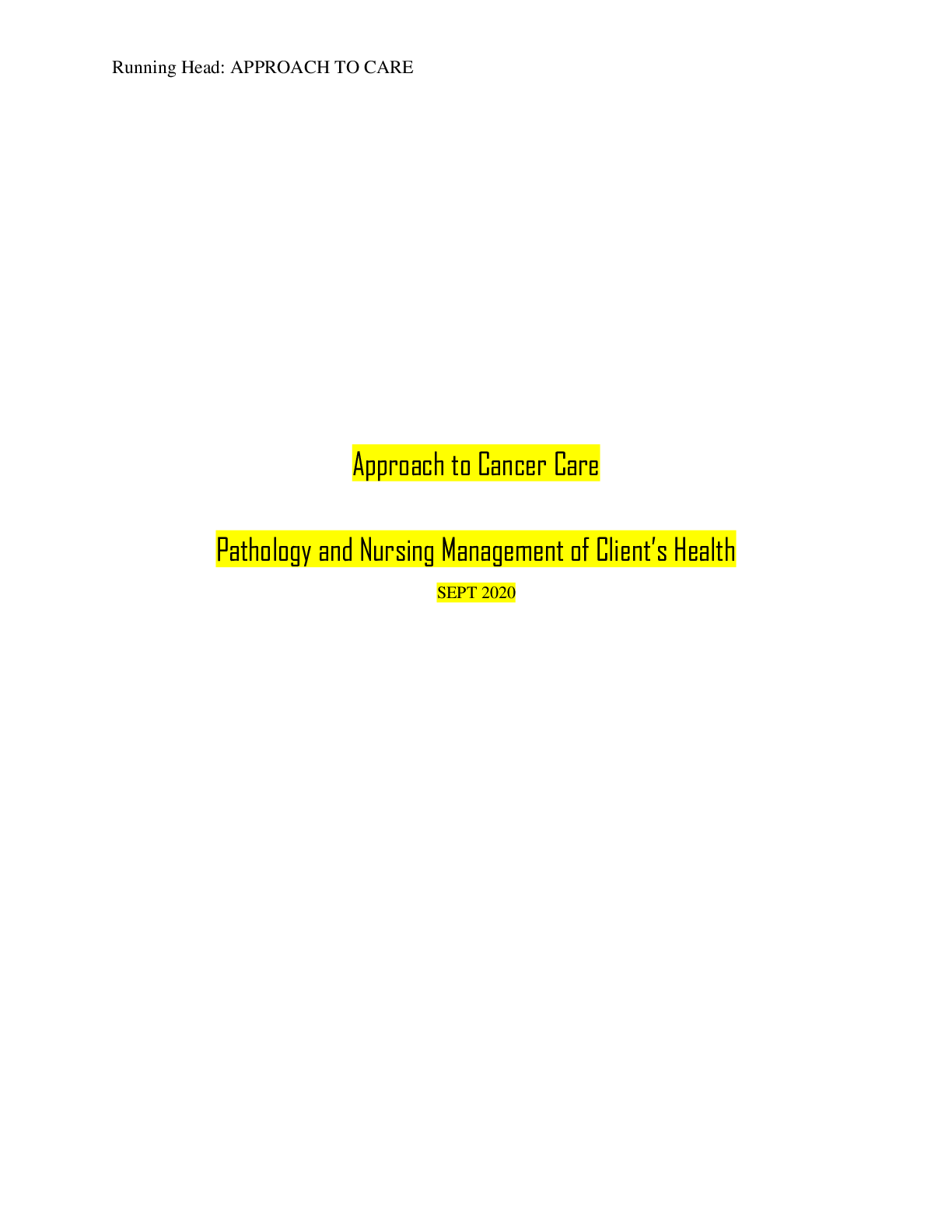*NURSING > QUESTIONS & ANSWERS > NRS 410V Week 2 Assignment, Approach to Care 1 (All)
NRS 410V Week 2 Assignment, Approach to Care 1
Document Content and Description Below
Diagnosis and staging of cancer Introduction Cancer is the second leading cause of death in the world. It is arguable the deadliest disease currently, due to the fact that it has no known cure as... well as having no known cause for it. It is caused by the abnormal growth of cells within the body. These cells can either clamp together or simply mutate to become toxic to the body. Instead of serving or working to help in the normal physiological functions, these cancerous cells do the opposite. This is due to its rapid nature in impairing the immune system and preventing the body from functioning properly. However, survival rates have improved as a result of improvements in diagnosis mechanism and treatment. Nevertheless, the aggressive nature of cancer treatment has brought complications just like the disease itself. As a result, this paper offers comprehensive details on the nature of cancer diagnosis and staging, complications, and methods used to lessen physical and psychological effects. Diagnosis Sometimes the condition can go unnoticed until it is in very advanced stages. It is very difficult to detect cancer for an individual, unless of course it affects very vital parts of one’s body, which one can feel. Cancer is suspected based on a person’s physical examination, symptoms, or the results of screening tests. Nevertheless, x-rays obtained for other reasons, such as injury, might show abnormalities that might be cancer. However, confirmation that cancer is present requires other tests generally known as diagnostic tests. In this case, most doctors’ perform a biopsy to make a diagnosis of cancer. A biopsy involves the removal of a sample of tissue, which is examined under the microscope by a pathologist. Consequently, it is only after cancer is diagnosed that its stage is identified. Checking for cancer is sometimes quite tedious, especially when there are no symptoms, since it means having to screen virtually all the main parts and organs of the body. Of course there are the common types of cancer, such as cervical, throat, prostate, lung, uterine and duodenal cancer, whose tests can be done first, before going for other parts. Staging Therefore, staging is way of describing how advanced the cancer has become. This involves the examination of how big it is and whether it has spread to neighboring tissues or more distantly to lymph nodes or other organs. In cancer treatment, staging is important as any given type of cancer is always referred to by the stage it was given during diagnosis. However, even if the cancer spreads and gets worse, the stage will not change. In contrast, the new information about the changes will be added on to the original stage (Edge, 2012). Although there are many cancer staging systems, majority of them capture information related to; location of the tumor, the cell type, size of the tumor, tumor grade, and whether the cancer has spread. As a result, staging of cancer is grouped into five; Stage 0, I, II, III, and IV. The higher the number, the larger the cancer tumor and the more it has spread into nearby tissues. The higher the number also means the more difficult it is to treat. For instance, Stage 0 indicates abnormal cells are present but have not spread while Stage IV indicates that the cancer has spread to distant tissues and the size of tumor is big. However, blood cancers, spinal cord, and brain cancers are complicated thus require complex staging systems. Complications and Symptoms The major complication related to cancer is its recurrence nature. When these cells are even destroyed, if in early stages, there is usually a high chance that more will mutate once more. Therefore, all cancer survivors have a risk of suffering from cancer again. However, some cancers such as breast and blood cancer are more likely to recur than others (Zhang, 2013). In such scenarios, periodic scans and exams are used to look for cancer recurrence. In addition, chemical changes in the body of cancer victims are normal. Cancer upsets the normal chemical balance in the body thus increasing the risks of further complications. Confusion, constipation, excessive thirst, and frequent urination are the major sign of chemical imbalances in the body. Cancer is also quite painful, especially as it advances to the later stages. The pain is as a result of the cancerous cells squeezing onto the internal organs or basically blocking some functions within the body. Additionally, the pain comes out as a result of the abnormal secretion of lytic enzyme, which impacts quite negatively on the body functions. The lytic enzymes are secreted due to the creation of an extremely acidic environment by the tumor (Hayat, 2009). In addition, brain cancer results into brain and nervous system complications. Cancerous cells in the brain put pressure on nearby nerves thus resulting into pain. Such complications can cause stroke-like signs that may weaken one part of the body. On the other hand, stomach cancer leads to complications in the immune system. The immune system may react to the presence of cancerous cells. However, since cancerous cells do not die, the immune system attacks other healthy cells as well. This complication is referred to as paraneoplastic syndrome and is characterized with difficulty in walking and seizures. As a result, it can be defined as the clinical or medical effects of the disease which are not really directly related to the cancer, but rather, due to its non-invasive nature (Darnell & Posner, 2011).It is a set of clinical anomalies. Management Cancer treatment and management is either through radiotherapy, chemotherapy or palliative care, based on the stage. The method selected is usually dependent on various factors. These factors include the age of the patient, the stage of the cancer itself, and also, the treatment plan taken for it. Each of these methods, except palliative care, has its own effects and side effects. Palliative care usually comes in when the cancer is at a very advanced stage, such as stage 3 or 4, and hence cannot be completely treated. The goal therefore becomes to reduce the painful aspects of it, and make the patient as comfortable as possible. The aggressive nature of chemotherapy results into severe complications on cancer patients. However each type of chemotherapy has its specific side effects. For instance, chemotherapy to the head or neck may injure the glands that produce saliva or damage the muscles of the jaw and neck. Therefore, each cancer patient experiences different side effects based on the type of cancer, dose and drugs, and general health of the patient (Pederson, 2013). Consequently, the general side effects of cancer treatments methods are muscle pain, stomach pain, headaches, nausea and vomiting, and pain from the nerves. With regards to side effects caused by cancer treatment, palliative care has become an important part of cancer treatment. According to Kissane (2017) palliative care doesn’t only focus on the reduction of the physical pain on the patient, but also the psychological wellbeing as well as that of the patient’s family. It is therefore a whole process on its own, focused on ensuring a conducive environment during end of life cases. As a result, many types of chemotherapy are easier to tolerate than they were few years ago. Consequently, doctors can give pain-relieving medications or adjust doses of chemotherapy as a way of treating the side effects. With regards to brain cancer, doctors can block pain signal from the nerves to the brain using nerve blocks. Therefore, treating of the side effect often differs based on what is causing it because there can be other pains besides the chemotherapy. Although treating the side effects cannot always prolong the patients’ life, it improves the quality of the remaining life. Conclusion In conclusion, cancer is a dangerous disease that has taken many lives. It continues to be dangerous due to the fact that its cause and also its treatment are still uknown. Chemotherapy and radiotherapy are still the most effective ways to handle it. However, through proper diagnosis, the cancer can be staged allowing the patient to receive sufficient medication. Nevertheless, the aggressive nature of cancer treatment methods has its own side effects just like the disease. Nonetheless, through palliative care, doctors can treat the side effects thus enhancing the quality of the patients’ life. References Darnell, R. B., & Posner, J. B. (2011). Paraneoplastic syndromes. Edge, S. B., & American Joint Committee on Cancer. (2012). AJCC cancer staging handbook: from the AJCC cancer staging manual (Vol. 2010, p. 718). New York: Springer. Hayat, M. A. (2009). Colorectal cancer: Colorectal cancer. Dordrecht: Springer. Kissane, D. (2017). Oxford textbook of communication in oncology and palliative care. Pedersen, B., Koktved, D. P., & Nielsen, L. L. (2013). Living with side effects from cancer treatment–a challenge to target information. Scandinavian journal of caring sciences, 27(3), 715-723. Zhang, Y., Schnabel, C. A., Schroeder, B. E., Jerevall, P. L., Jankowitz, R. C., Fornander, T., ... & Erlander, M. (2013). Breast cancer index identifies early stage ER+ breast cancer patients at risk for early and late distant recurrence. Clinical Cancer Research, clincanres-0804. [Show More]
Last updated: 2 years ago
Preview 1 out of 6 pages

Buy this document to get the full access instantly
Instant Download Access after purchase
Buy NowInstant download
We Accept:

Reviews( 0 )
$4.00
Can't find what you want? Try our AI powered Search
Document information
Connected school, study & course
About the document
Uploaded On
Apr 07, 2020
Number of pages
6
Written in
Additional information
This document has been written for:
Uploaded
Apr 07, 2020
Downloads
0
Views
108







.png)









